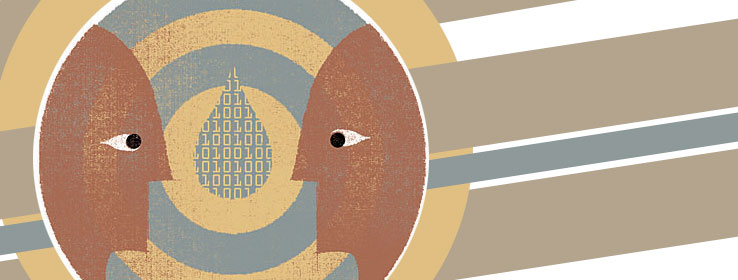Why is it so challenging to match computer colors to their real-life counterparts?
Relying on technology to specify colors is like holding a paint chip to the sky to match its blue: Precision is just out of reach, and always will be.
However, that doesn't mean you can't come close. Online tools that "paint" spaces can give clients a jumping-off point, as well as a confidence-inspiring shot of, "Oh, so that's how this color will look in my room." Color exactitude, however, is still very much a paint-on-site, in-the-right-light exercise.
"I don't know that we're ever going to be in a place where online color matches off-line," says Lynn Longbrake, associate director of creative at Resource Interactive, a Columbus, Ohio-based digital marketing agency. They're too physically different. Virtual color is communicated by light beaming directly into our eyes. Real-world color is reflected, or light shining on a physical object reflecting into our eyes. "These worlds," says Longbrake, "will never be synonymous."
Nonetheless, the quest to come ever closer continues on the part of manufacturers, as well as designers. Software such as Adobe Photoshop® builds in its own color profile.
Design professionals debate how to calibrate individual monitors to their most center points so colors don't skew. ("Monitors aren't typically set for the best color calibration, but for text readability: for crispness of type and for contrast," Longbrake says. "They tend to have a bluish tone to them.")
Designers who are serious about color must continually recalibrate their monitors to correct for shifting variables, says Peter Gerstmann, application architect at Resource Interactive. “Your monitor’s getting older, it’s been on X amount of time, the light of day is changing …” But a recalibrated monitor does not ensure perfection: The computers to which you’re transmitting images are far from universal, thanks to their different manufacturers, operating systems, software, versions, desktop positions and surrounding glare.
"Computer monitors are like snowflakes: No one is like the other," says Longbrake.
The difference between screen and printed colors can be even more variable. On the printed page, tiny dots of cyan, magenta, yellow and black (CMYK) pigments render the optical illusion of different colors. On the screen, the "same" color is composed of red, green and blue (RGB), the primary colors of light. Getting them to match is like trying to cook the same dish with different ingredients.
Clearly, the sky is not the limit when it comes to achieving color consistency between media. Make the adjustments you can, while accepting that you can't change the underlying technology, says Gerstmann. "Sometimes it's enough to get it good enough."
Point & paint
You can help your clients gain inspiration and peace of mind by dragging and dropping 1,700-plus colors from the Sherwin-Williams palette onto a variety of interior spaces and exterior facades ― and onto your own photos once you've uploaded them ― via the Sherwin-Williams Color Visualizer. It's easy to search the Color Visualizer by color family, collection, specific name or number. Actual design concepts can also be "painted" by downloading colors into AutoCAD® and Photoshop®. Kitty Shea is a Minnesota-based freelance writer who specializes in interior design.







